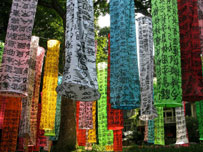 |
| Le Quoc Viet’s illuminated fabric lantern pillars, on which are written in vignettes of Vietnamese literature using Han and Nom calligraphy. |
A calligraphic installation called Secret Mantra by Le Quoc Viet will be displayed from August 18 – 24 on the premises of the Indochina Arts Partnership in Massachusetts, USA.
The exhibition features illuminated fabric lantern pillars, on which are written vignettes of ancient Vietnamese literature using Han and Nom calligraphy.
Han and Nom are the scripts that Vietnamese was written in before the current Latinized script was adopted.
Viet said the pillars were inspired by the octagonal stone pillars with the carving of Mantras in Han characters following their Sanskrit pronunciation that were unearthed by Vietnamese archeologists last century in the ancient capital of Hoa Lu (Ninh Binh Province nowadays).
According to the writing on the pillars, Prince Dinh Khuong Lien (son of the king Dinh Bo Linh (924-979) killed his brother and then, greatly regretting it, placed 100 stone pillars at 100 road intersections for people passing by to read as a way of praying by chanting and remembering his brother.
Chanting mantras is one of the practices of the Vajrayana Buddhism. A mantra can be read silently or chanted aloud as a prayer for happiness, transformation of the soul or to eliminate sins committed by human beings. Over time, this practice led to the ceremonial practice of creating stone pillars with mantras carved on them.
Viet said his installation is about losing the root language of Vietnam and everything that the loss entails. His art focuses on using history as a metaphor that can be applied in present times.
“My intent is to invite the audience to be participants in my work, completing my vision between their movement and the stillness of the lanterns.
“As for me, I will be standing at a distance, longing for the past with nostalgia – from the Eastern perspective of a Vietnamese who has lost the Han language – observing the installations and all of you – Westerners wearing modern outfits decorated with Asian scripts.”
Founded in 1988, the non-profit Indochina Arts Partnership conducts programs of cultural development and artistic exchange between the United States and the countries of Southeast Asia, with a primary focus on Vietnam.

Leave your comment on this story